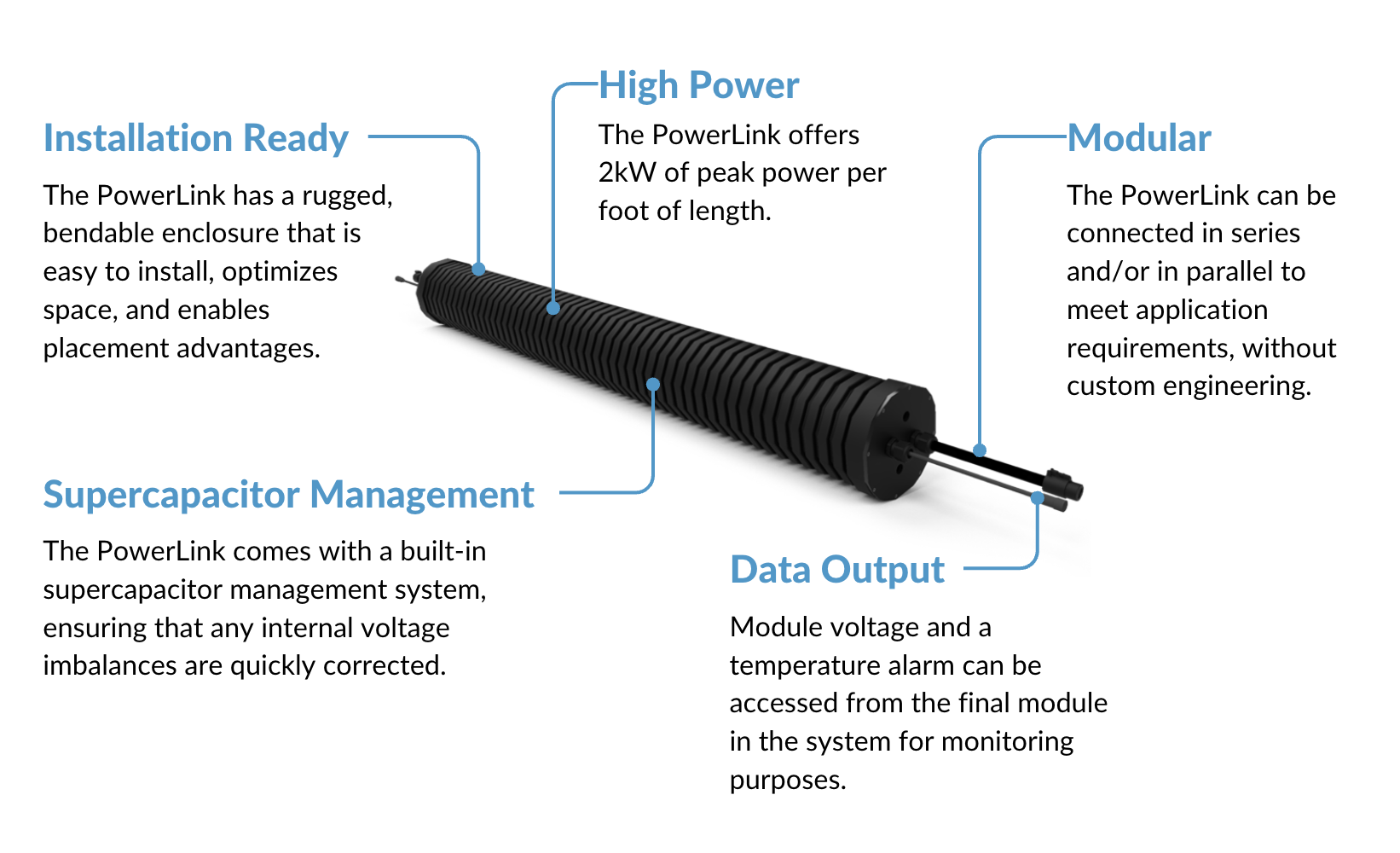
Here’s the truth:
Modern loads are complex. Both long duration and rapid response energy storage are critical to our future.
The Rapid Response Energy Storage Solution
-
The PowerLink is modular solution that can be easily scaled to higher voltages or power levels with series and parallel connections. Thanks to the pre-installed connectors - this is only a matter of matching up male and female ends that snap together.
-
Part of our mission is to make supercapacitors effective and easy to use. To do that, we use reliable and high quality supercapacitors that we’ve paired with the kind of high power cell balancing required to correct voltage imbalances, energy management algorithms, data export capabilities, and passive cooling systems needed. The solution’s modularity makes it very easy to meet application voltage, current, energy, and power requirements following a few simple design rules of thumb described in our user manual.
-
The PowerLink is designed and produced to be quickly and easily installed, unlike any other supercapacitor solution on the market. Simply connect modules together to form the energy storage system needed by the application. Each module weighs ~15lbs (7kg) so they can be easily installed, moved, or reconfigured without forklifts or risking injury to your crew.
-
The PowerLink is durable, while also flexible. The corrugated body of its enclosure can withstand a peak load value of 320N. Each module is protected by a fuse and our market leading high power balancing system to ensure there are no dangerous voltage imbalances between supercapacitor cells. While competitors offer a “balancing system” too, it is often passive or low power. Capacitech’s approach corrects imbalances 20x faster, making it among the safest supercapacitor products on the market.
-
The PowerLink uses supercapacitor technology, which features a very high power density. This high power density is critical to rapid response capabilities, long operating life, and ability to handle high power levels. The high power density is made possible by a very low internal resistance that results in a very small voltage drop for high power use cases (such as when providing inrush current) compared to alternatives like batteries.
-
The PowerLink’s enclosure can be bent, which is really helpful when optimizing space. Being conformal, the PowerLink offers placement advantages for microgrids, datacenters, substations, and solar farms. While most supercapacitors come in a large container or cabinet that are heavy, large, and hard to install, the PowerLink can be routed through available space or even installed as part of traditional wire and cable infrastructure.
Key product features:
The PowerLink is an installation ready, high power, rapid response energy storage solution that makes supercapacitors scalable, effective, and easy to use that is available in hundreds of different configurations to meet project requirements at any scale.

We Are Here to Help
“The PowerLink solves a suite of reliability challenges by enhancing power quality, protecting batteries, and smoothing renewables. Lets connect and discuss your power resilience strategy. ”
- Alisa Silverstein | Application Engineer
Applications
The PowerLink is necessary for grid and microgrid operations, is 3-5x cheaper per kW than batteries, and highly versatile.
Impact
We’re Here to Help
Common PowerLink Configurations:
PL-12S1P
Modules: 12
Voltage Range: 60-720V
Peak Power: 100kW
Use Case: Microgrid inrush current from transformers
PL-12S4P
Modules: 48
Voltage Range: 60-720V
Peak Power: 398kW
Use Case: Solar Smoothing via Trunk Bus
The PowerLink is a modular solution. Modules connect in series parallel to meet voltage, current, power, and energy storage requirements. Module specifications:
Operating voltage range: 5V to 60V
Operating temperature range: -40C to 65C
Peak Power Capacity: 8,388W
Energy Storage Capacity: 7.2Wh
Cycle Life: >500,000 cycles
Specifications like maximum operating voltage, peak power capacity, and energy storage capacity are a multiple of the number of modules used.
More Resilience Less Downtime
An ideal energy storage system features both batteries and supercapacitors.
Not all energy storage devices are created equally. Not even all batteries are created equally. At its highest level, there are devices designed to deliver energy over long periods of time and there are other devices designed to deliver energy very quickly. An ideal energy storage system will feature both.
For example, batteries and fuel cells are designed to deliver energy over long periods of time. Supercapacitors are designed to charge and deliver energy quickly. Many applications require the capabilities of both, but there is only enough space for one or the other leading to a difficult engineering tradeoff. The PowerLink alleviates that challenge leveraging form factor to fit supercapacitors within available space in the system.
No tradeoff.
The engineering tradeoff to adopt supercapacitors for batteries is high due to the lack of space to add them. To add supercapacitors generally means to use fewer (or smaller) batteries. Capacitech installs supercapacitors in new places to avoid these kind of design tradeoffs.
More power.
Supercapacitors are powerful. They feature a very high power density to deliver >10x more power than batteries. The benefit of having more power, is the ability to turn on a larger load than what batteries can on their own. By connecting supercapacitors in series and parallel, supercapacitors can complement batteries from small electronics to solar farm applications.
Discrete.
Capacitech’s form factor innovations are designed to be a discrete and distributed network of supercapacitors running between solar panels, batteries, inverters, and the loads they are powering. We optimize design and performance to reduce additional capital expense and ongoing operating expenses.









